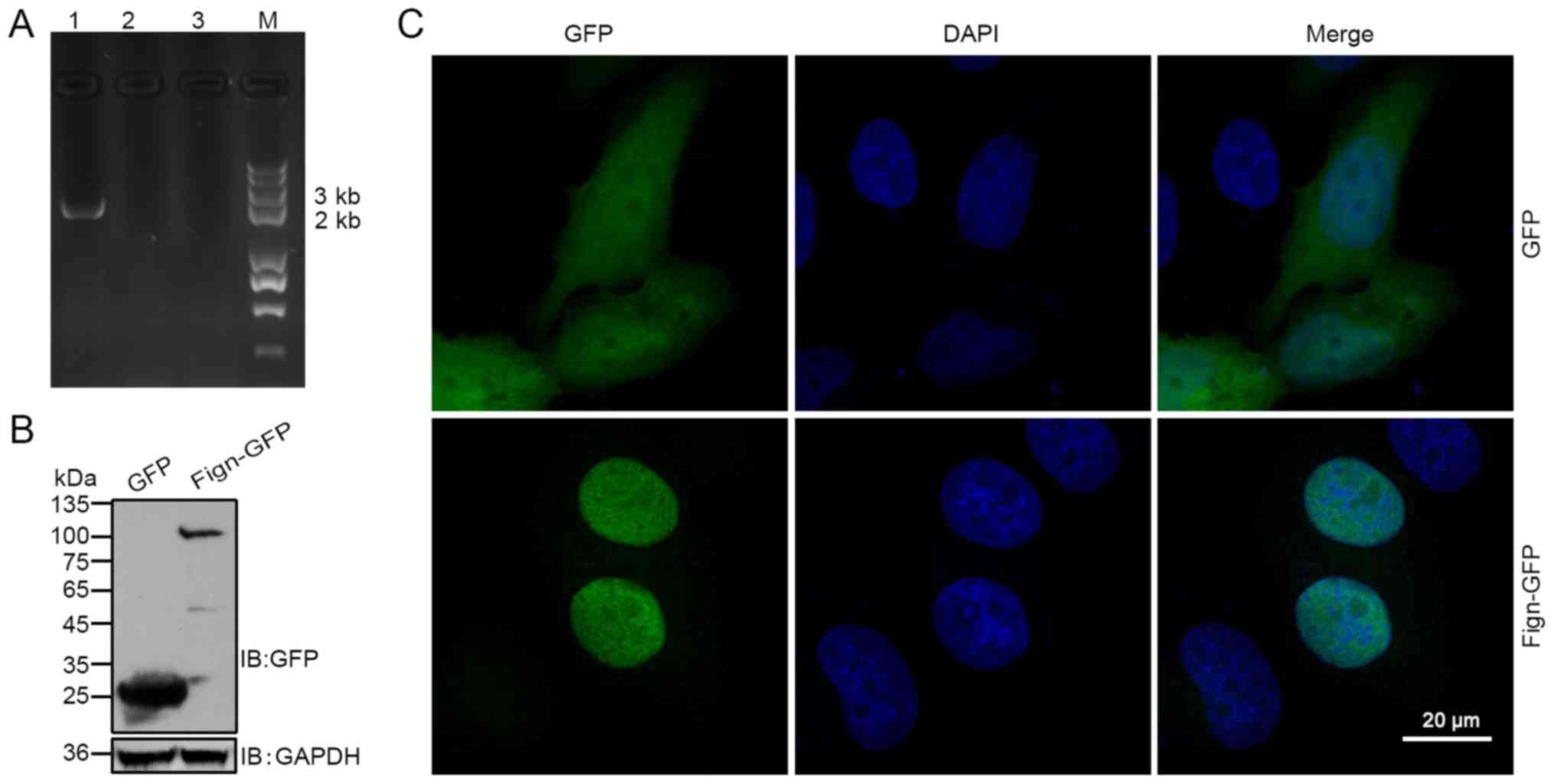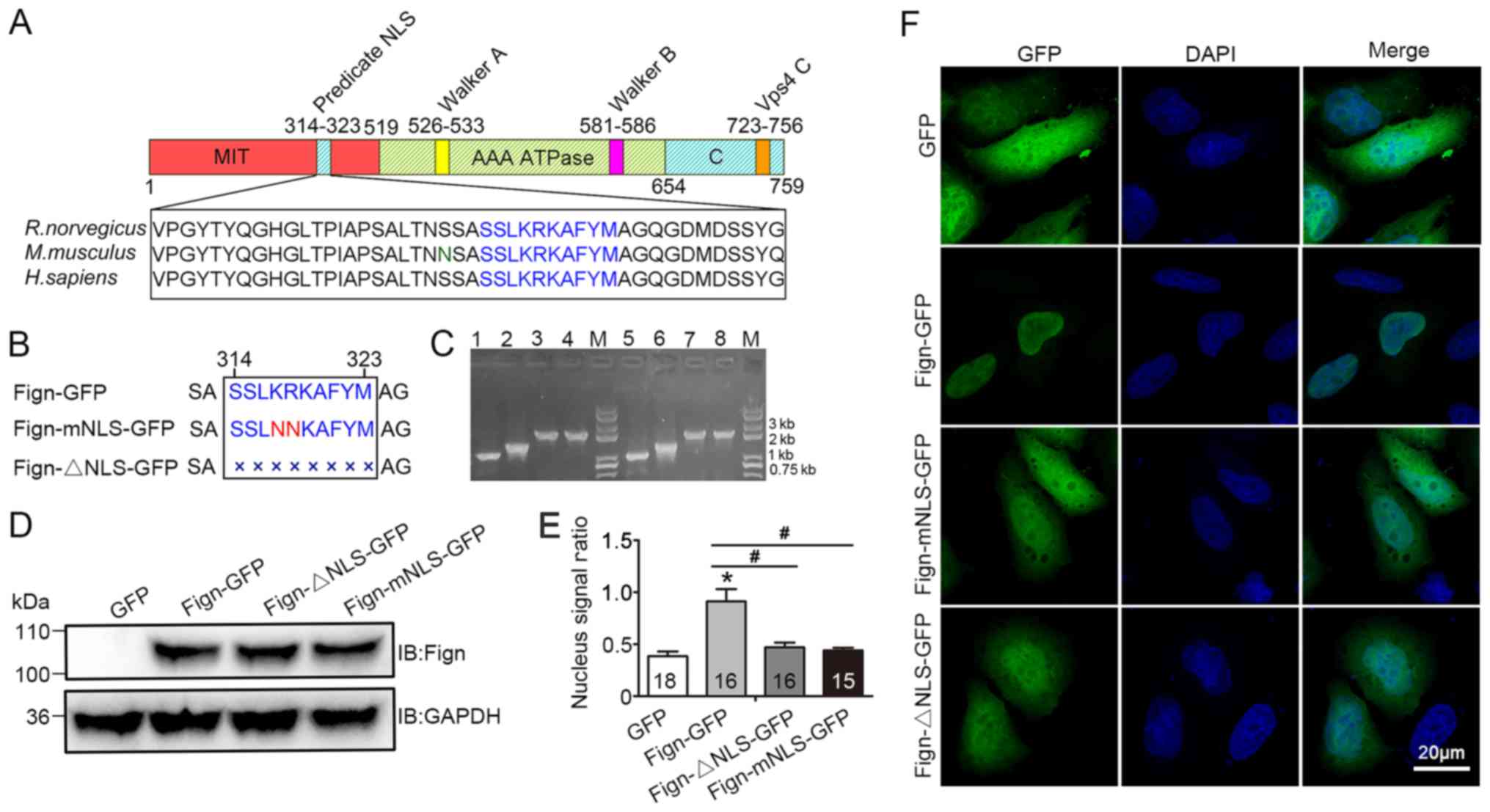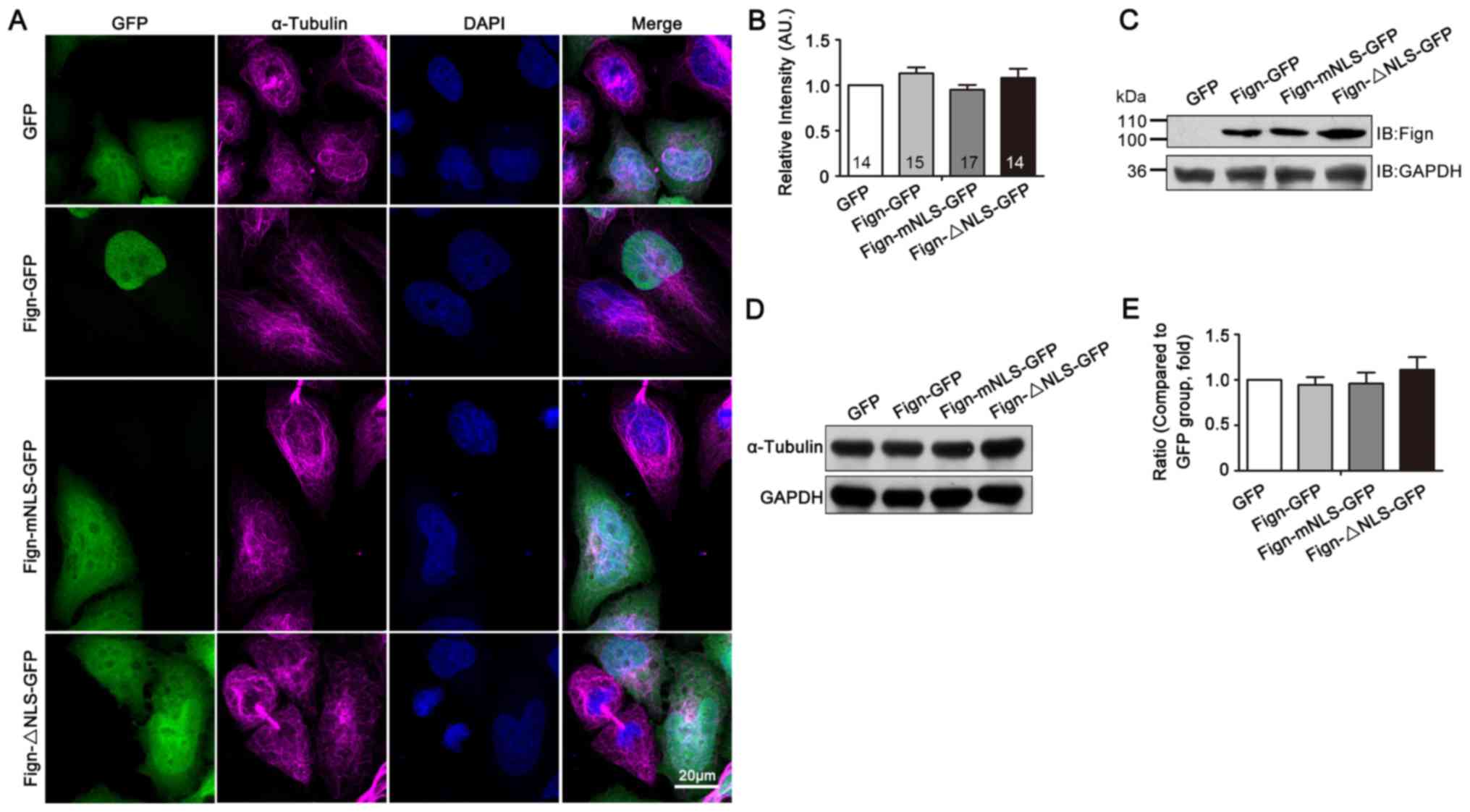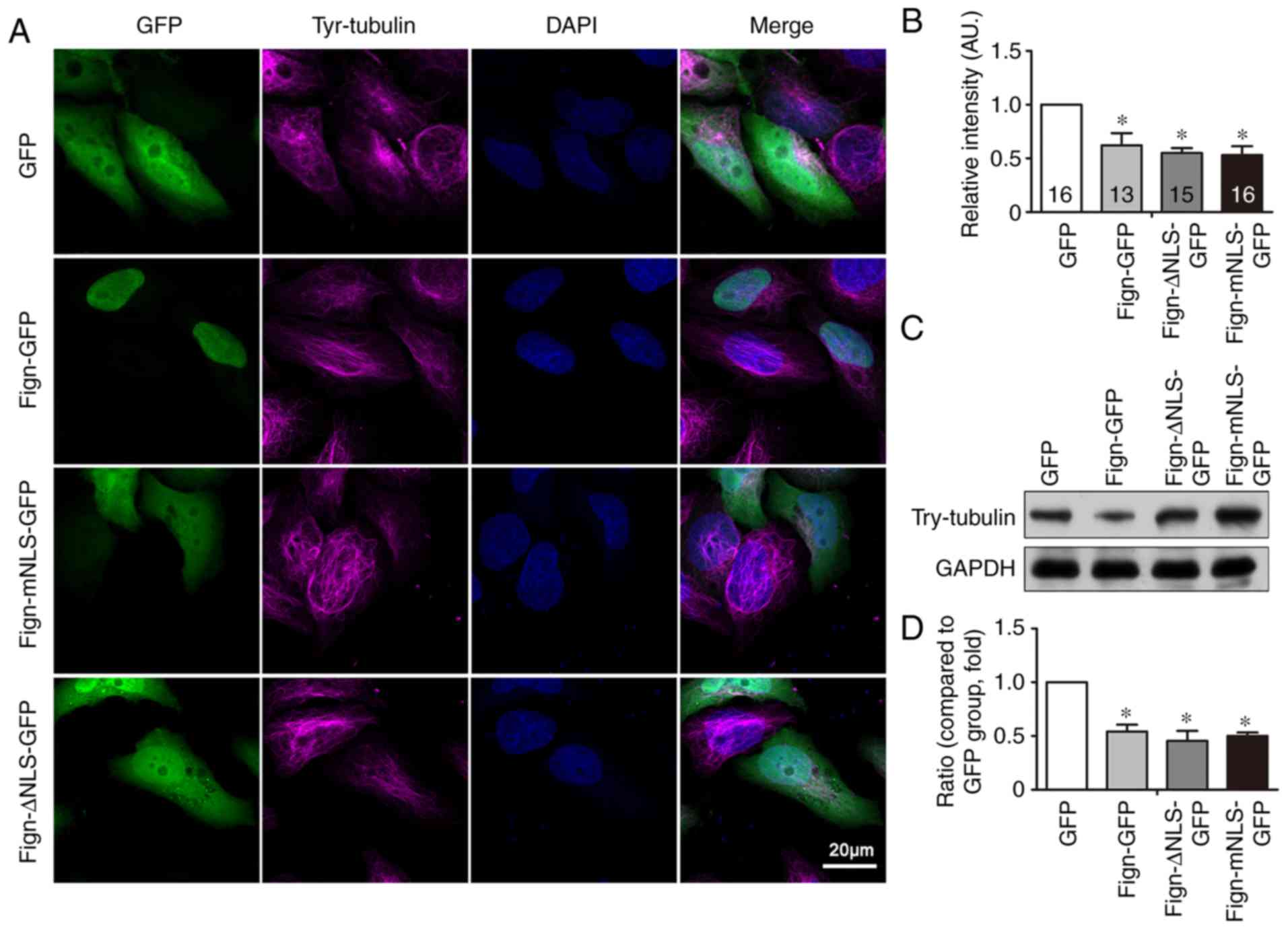|
1
|
Fletcher DA and Mullins RD: Cell mechanics
and the cytoskeleton. Nature. 463:485–492. 2010. View Article : Google Scholar : PubMed/NCBI
|
|
2
|
Guerin CM and Kramer SG: Cytoskeletal
remodeling during myotube assembly and guidance: Coordinating the
actin and microtubule networks. Commun Integr Biol. 2:452–457.
2009. View Article : Google Scholar : PubMed/NCBI
|
|
3
|
Kapitein LC and Hoogenraad CC: Building
the neuronal microtubule cytoskeleton. Neuron. 87:492–506. 2015.
View Article : Google Scholar : PubMed/NCBI
|
|
4
|
Lasser M, Tiber J and Lowery LA: The role
of the microtubule cytoskeleton in neurodevelopmental disorders.
Front Cell Neurosci. 12:1652018. View Article : Google Scholar : PubMed/NCBI
|
|
5
|
Barlan K and Gelfand VI: Microtubule-based
transport and the distribution, tethering, and organization of
organelles. Cold Spring Harb Perspect Biol. 9(pii): a0258172017.
View Article : Google Scholar : PubMed/NCBI
|
|
6
|
Lipka J, Kuijpers M, Jaworski J and
Hoogenraad CC: Mutations in cytoplasmic dynein and its regulators
cause malformations of cortical development and neurodegenerative
diseases. Biochem Soc Trans. 41:1605–1612. 2013. View Article : Google Scholar : PubMed/NCBI
|
|
7
|
Reiner O and Sapir T: LIS1 functions in
normal development and disease. Curr Opin Neurobio. 23:951–956.
2013. View Article : Google Scholar
|
|
8
|
Liu Y, Lee JW and Ackerman SL: Mutations
in the microtubule-associated protein 1A (Map1a) gene cause
Purkinje cell degeneration. J Neurosci. 35:4587–4598. 2015.
View Article : Google Scholar : PubMed/NCBI
|
|
9
|
Mukherjee S, Diaz Valencia JD, Stewman S,
Metz J, Monnier S, Rath U, Asenjo AB, Charafeddine RA, Sosa HJ,
Ross JL, et al: Human Fidgetin is a microtubule severing the enzyme
and minus-end depolymerase that regulates mitosis. Cell Cycle.
11:2359–2366. 2012. View
Article : Google Scholar : PubMed/NCBI
|
|
10
|
Ghosh DK, Dasgupta D and Guha A: Models,
regulations, and functions of microtubule severing by Katanin. ISRN
Mol Biol. 2012:5962892012. View Article : Google Scholar : PubMed/NCBI
|
|
11
|
Yang Y, Mahaffey CL, Bèrubè N, Nystuen A
and Frankel WN: Functional characterization of fidgetin, an
AAA-family protein mutated in fidget mice. Exp Cell Res. 304:50–58.
2005. View Article : Google Scholar : PubMed/NCBI
|
|
12
|
Cox GA, Mahaffey CL, Nystuen A, Letts VA
and Frankel WN: The mouse fidgetin gene defines a new role for AAA
family proteins in mammalian development. Nat Genet. 26:198–202.
2000. View Article : Google Scholar : PubMed/NCBI
|
|
13
|
Yang Y, Mahaffey CL, Bérubé N and Frankel
WN: Interaction between fidgetin and protein kinase A-anchoring
protein AKAP95 is critical for palatogenesis in the mouse. J Biol
Chem. 281:22352–22359. 2006. View Article : Google Scholar : PubMed/NCBI
|
|
14
|
Eckert T, Le DT, Link S, Friedmann L and
Woehlke G: Spastin's microtubule-binding properties and comparison
to katanin. PLoS One. 7:e501612012. View Article : Google Scholar : PubMed/NCBI
|
|
15
|
Grimm I, Saffian D, Platta HW and Erdmann
R: The AAA-type ATPases Pex1p and Pex6p and their role in
peroxisomal matrix protein import in Saccharomyces cerevisiae.
Biochim Biophys Acta. 1823:150–158. 2012. View Article : Google Scholar : PubMed/NCBI
|
|
16
|
White SR and Lauring B: AAA+ ATPases:
Achieving diversity of function with conserved machinery. Traffic.
8:1657-16672007.
|
|
17
|
Snider J, Thibault G and Houry WA: The
AAA+ superfamily of functionally diverse proteins. Genome Biol.
9:2162008. View Article : Google Scholar : PubMed/NCBI
|
|
18
|
Onitake A, Yamanaka K, Esaki M and Ogura
T: Caenorhabditis elegans fidgetin homolog FIGL-1, a
nuclear-localized AAA ATPase, binds to SUMO. J Struct Biol.
179:143–151. 2012. View Article : Google Scholar : PubMed/NCBI
|
|
19
|
Leo L, Yu W, D'Rozario M, Waddell EA,
Marenda DR, Baird MA, Davidson MW, Zhou B, Wu B, Baker L, et al:
Vertebrate Fidgetin restrains axonal growth by severing labile
domains of microtubules. Cell Rep. 12:1723–1730. 2015. View Article : Google Scholar : PubMed/NCBI
|
|
20
|
Sharp DJ and Ross JL: Microtubule-severing
enzymes at the cutting edge. J Cell Sci. 125:2561–2569. 2012.
View Article : Google Scholar : PubMed/NCBI
|
|
21
|
Lupas AN and Martin J: AAA proteins. Curr
Opin Struct Biol. 12:746–753. 2002. View Article : Google Scholar : PubMed/NCBI
|
|
22
|
Vale RD: AAA proteins. J Cell Biol.
150:F13–F19. 2000. View Article : Google Scholar : PubMed/NCBI
|
|
23
|
Zhang D, Rogers GC, Buster DW and Sharp
DJ: Three microtubule severing enzymes contribute to the
‘Pacman-flux’ machinery that moves chromosomes. J Cell Biol.
177:231–242. 2007. View Article : Google Scholar : PubMed/NCBI
|
|
24
|
Spit A, Hyland RH, Mellor EJ and Casselton
LA: A role for heterodimerization in nuclear localization of a
homeodomain protein. Proc Natl Acad Sci USA. 95:6228–6233. 1998.
View Article : Google Scholar : PubMed/NCBI
|
|
25
|
Hunter CC, Siebert KS, Downes DJ, Wong KH,
Kreutzberger SD, Fraser JA, Clarke DF, Hynes MJ, Davis MA and Todd
RB: Multiple nuclear localization signals mediate nuclear
localization of the GATA transcription factor AreA. Eukaryot Cell.
13:527–538. 2014. View Article : Google Scholar : PubMed/NCBI
|
|
26
|
LaCasse EC and Lefebvre YA: Nuclear
localization signals overlap DNA- or RNA-binding domains in nucleic
acid-binding proteins. Nucleic Acids Res. 23:1647–1656. 1995.
View Article : Google Scholar : PubMed/NCBI
|
|
27
|
Kosugi S, Hasebe M, Matsumura N, Takashima
H, Miyamoto-Sato E, Tomita M and Yanagawa H: Six classes of nuclear
localization signals specific to different binding grooves of
importin alpha. J Biol Chem. 284:478–485. 2009. View Article : Google Scholar : PubMed/NCBI
|
|
28
|
Melnikov S, Ben-Shem A, Yusupova G and
Yusupov M: Insights into the origin of the nuclear localization
signals in conserved ribosomal proteins. Nat Commun. 6:73822015.
View Article : Google Scholar : PubMed/NCBI
|
|
29
|
Nakielny S and Dreyfuss G: Import and
export of the nuclear protein import receptor transportin by a
mechanism independent of GTP hydrolysis. Curr Biol. 8:89–95. 1998.
View Article : Google Scholar : PubMed/NCBI
|
|
30
|
Wang R and Brattain MG: The maximal size
of protein to diffuse through the nuclear pore is larger than 60
kDa. FEBS Lett. 581:3164–3170. 2007. View Article : Google Scholar : PubMed/NCBI
|
|
31
|
Freitas N and Cunha C: Mechanisms and
signals for the nuclear import of proteins. Curr Genomics.
10:550–557. 2009. View Article : Google Scholar : PubMed/NCBI
|
|
32
|
Marfori M, Mynott A, Ellis JJ, Mehdi AM,
Saunders NF, Curmi PM, Forwood JK, Bodén M and Kobe B: Molecular
basis for specificity of nuclear import and prediction of nuclear
localization. Biochim Biophys Acta. 1813:1562–1577. 2011.
View Article : Google Scholar : PubMed/NCBI
|
|
33
|
Hu Z, Feng J, Bo W, Wu R, Dong Z, Liu Y,
Qiang L and Liu M: Fidgetin regulates cultured astrocyte migration
by severing tyrosinated microtubules at the leading edge. Mol Biol
Cell. 28:545–553. 2017. View Article : Google Scholar : PubMed/NCBI
|
|
34
|
Kaverina I and Straube A: Regulation of
cell migration by dynamic microtubules. Semin Cell Dev Biol.
22:968–974. 2011. View Article : Google Scholar : PubMed/NCBI
|
|
35
|
Muroyama A and Lechler T: Microtubule
organization, dynamics and functions in differentiated cells.
Development. 144:3012–3021. 2017. View Article : Google Scholar : PubMed/NCBI
|
|
36
|
Mitchison T and Kirschner M: Dynamic
instability of microtubule growth. Nature. 312:237–242. 1984.
View Article : Google Scholar : PubMed/NCBI
|
|
37
|
Song Y and Brady ST: Post-translational
modifications of tubulin: Pathways to functional diversity of
microtubules. Trends Cell Biol. 25:125–136. 2015. View Article : Google Scholar : PubMed/NCBI
|
|
38
|
Audagnotto M and Dal Peraro M: Protein
post-translational modifications: In silico prediction tools and
molecular modeling. Comput Struct Biotechnol J. 15:307–319. 2017.
View Article : Google Scholar : PubMed/NCBI
|
|
39
|
Howes SC, Alushin GM, Shida T, Nachury MV
and Nogales E: Effects of tubulin acetylation and tubulin
acetyltransferase binding on microtubule structure. Mol Biol Cell.
25:257–266. 2014. View Article : Google Scholar : PubMed/NCBI
|
|
40
|
Magiera MM and Janke C: Post-translational
modifications of tubulin. Curr Biol. 24:R351–R354. 2014. View Article : Google Scholar : PubMed/NCBI
|
|
41
|
Janke C and Bulinski JC:
Post-translational regulation of the microtubule cytoskeleton:
Mechanisms and functions. Nat Rev Mol Cell Biol. 12:773–786. 2011.
View Article : Google Scholar : PubMed/NCBI
|
|
42
|
Fukushima N, Furuta D, Hidaka Y, Moriyama
R and Tsujiuchi T: Post-translational modifications of tubulin in
the nervous system. J Neurochem. 109:683–693. 2009. View Article : Google Scholar : PubMed/NCBI
|
|
43
|
Schneider N, Ludwig H and Nick P:
Suppression of tubulin detyrosination by parthenolide recruits the
plant-specific kinesin KCH to cortical microtubules. J Exp Bot.
66:2001–2011. 2015. View Article : Google Scholar : PubMed/NCBI
|
|
44
|
Roll-Mecak A and Vale RD: Structural basis
of microtubule severing by the hereditary spastic paraplegia
protein spastin. Nature. 451:363–367. 2008. View Article : Google Scholar : PubMed/NCBI
|


















